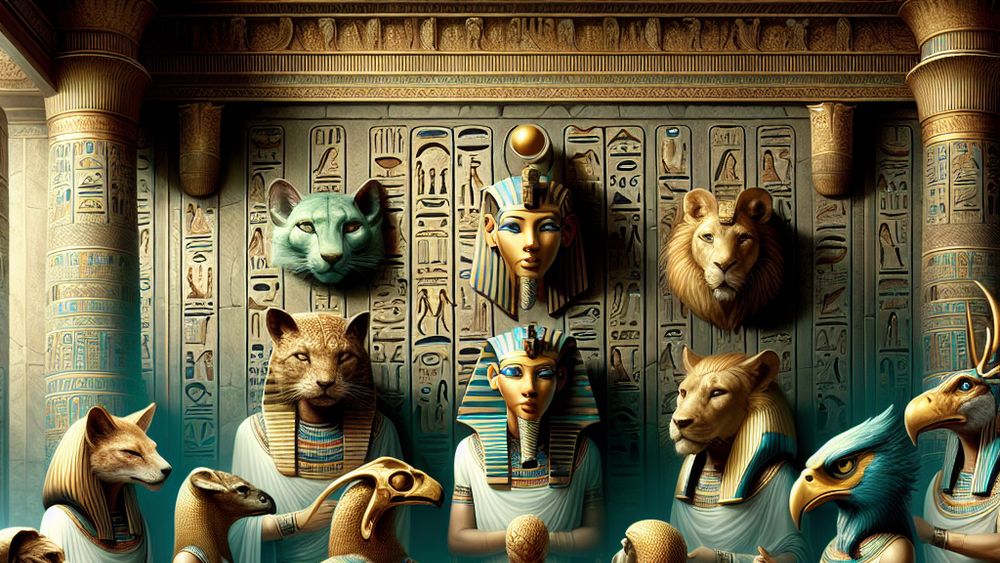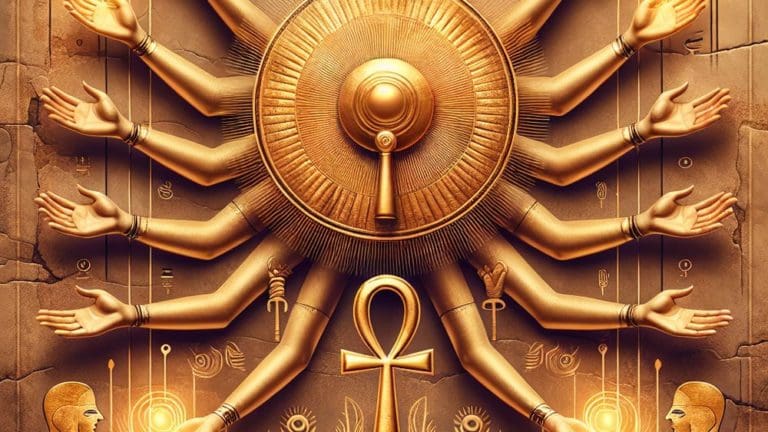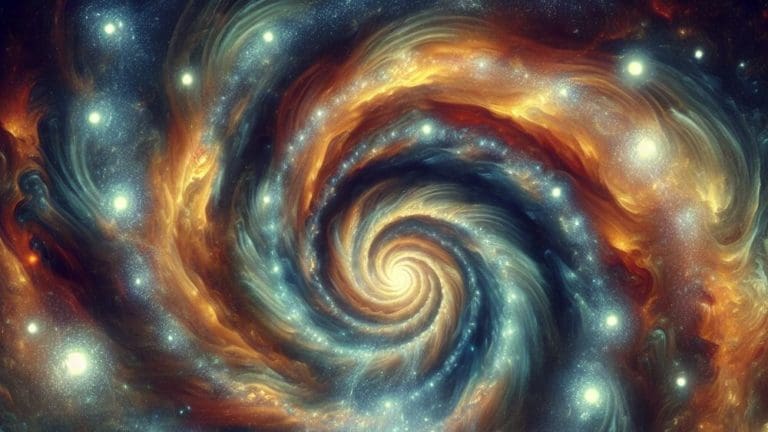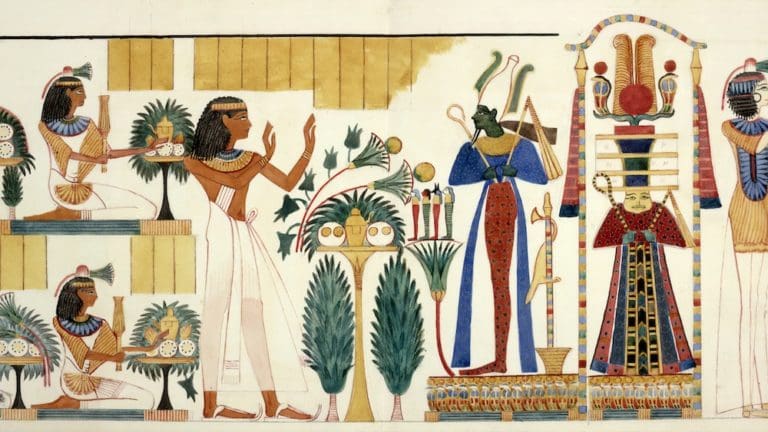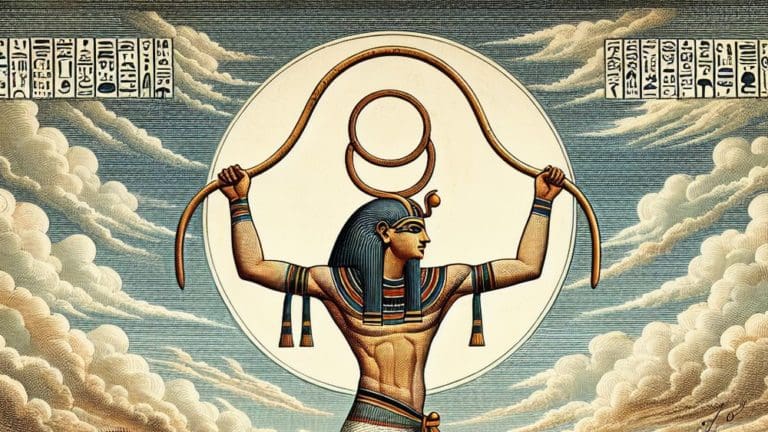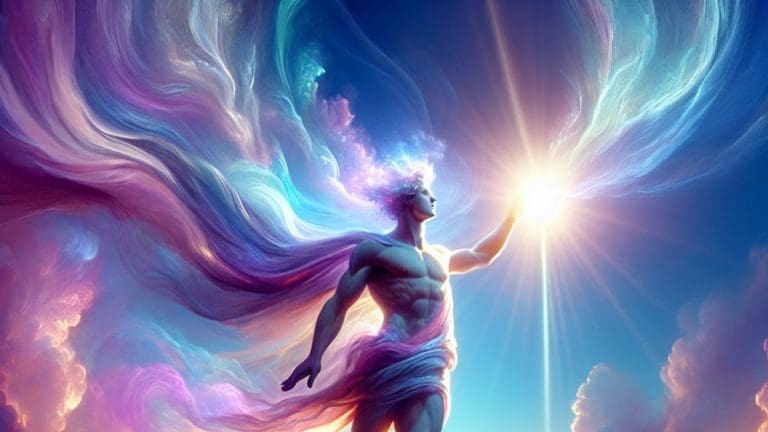Unveiling The Symbolism: Why Egyptian Gods Have Animal Heads
Unveiling The Symbolism: Why Egyptian Gods Have Animal Heads
Have you ever pondered the question, “Why do Egyptian gods have animal heads?” This mystery is as fascinating as it is ancient, inviting us into a world where deities stride the line between human and beast. It’s a unique feature that sets Egyptian mythology apart from other ancient beliefs, a testament to the complexity and richness of their culture. There’s something inherently captivating about looking into the eyes of a jackal-headed Anubis or the falcon visage of Horus. These images beckon us to dive deeper, to unravel the symbolism and stories behind these extraordinary hybrid forms.
Key Points:
- Egyptian gods had animal heads to symbolize characteristics and powers.
- The animal-headed deities bridged the gap between natural and supernatural realms.
- Animals were revered in Egyptian culture as embodiments of gods.
- Animal-headed gods influenced Egyptian society’s understanding of the divine.
- Modern practices influenced by animal-headed gods are seen in symbolic forms.
- The concept of theriocephaly depicted gods with animal heads on human bodies.
- Animal forms of gods in Egyptian mythology connected the earth to the sky and life to the afterlife.
Understanding why Egyptian gods have animal heads is not just about unearthing a fact in history; it’s about connecting with the mindset of an ancient civilization. Their gods were more than religious figures; they were integral to every aspect of life and the afterlife. As we embark on this journey through time, we find ourselves walking alongside the Egyptians themselves, trying to glimpse the world through their eyes. The animal heads are not merely artistic expressions but rich in meanings and messages, reflecting the essence of the very gods they represent.
Exploring the Symbolic Essence of Animal-Headed Deities in Ancient Egypt
In ancient Egypt, the gods were the very fabric of existence, intertwining the natural and supernatural into a cohesive worldview. This fusion is vividly illustrated through the depiction of deities with animal heads, a practice stemming from profound reverence for the characteristics and powers they believed these animals embodied. This symbolic essence allowed the Egyptians to depict and understand their gods in a form that was both accessible and mystifying, bridging the gap between the celestial and the terrestrial.
The Historical Context of Animal Worship in Ancient Egypt
Ancient Egyptians’ relationship with animals was deeply rooted in their culture and religion, reflected in their gods’ depiction. This relationship was not merely adoration but a complex belief system where animals were seen as physical representations of divine principles and natural forces.
- Sacred animals like the ibis, falcon, and jackal were worshipped as physical manifestations of thoth, Horus, and Anubis, respectively.
- Temples and shrines were dedicated to animal gods, underscoring their importance in daily life and the afterlife.
- Mummification of animals was practiced, mirroring the treatment of humans and indicating a belief in their sacred nature.
Ancient Egyptians revered animals as divine beings, embodying spiritual principles and forces, worshiping sacred creatures such as ibis, falcon, and jackal as physical manifestations of their gods.
The Concept of Theriocephaly and Its Significance
The concept of theriocephaly, the depiction of gods with animal heads on human bodies, was a significant aspect of Egyptian religious art. This practice was not arbitrary but laden with symbolism, each animal head chosen to convey specific qualities or powers believed to be integral to the deity it represented.
- Communication of divine attributes was more efficient through animal forms; for example, the wisdom of Thoth was aptly symbolized by the ibis head, known for its deliberate and calculated movements.
- Theriocephalic deities served as intermediaries between the human and divine realms, embodying the qualities that allowed them to navigate both worlds with ease.
Major Animal-Headed Gods and Their Symbolic Meanings
The pantheon of Egyptian gods is vast and varied, each with its own unique form and role within mythology. Below is a table summarizing a few of the major animal-headed gods and the symbolic meanings attributed to their animal forms.
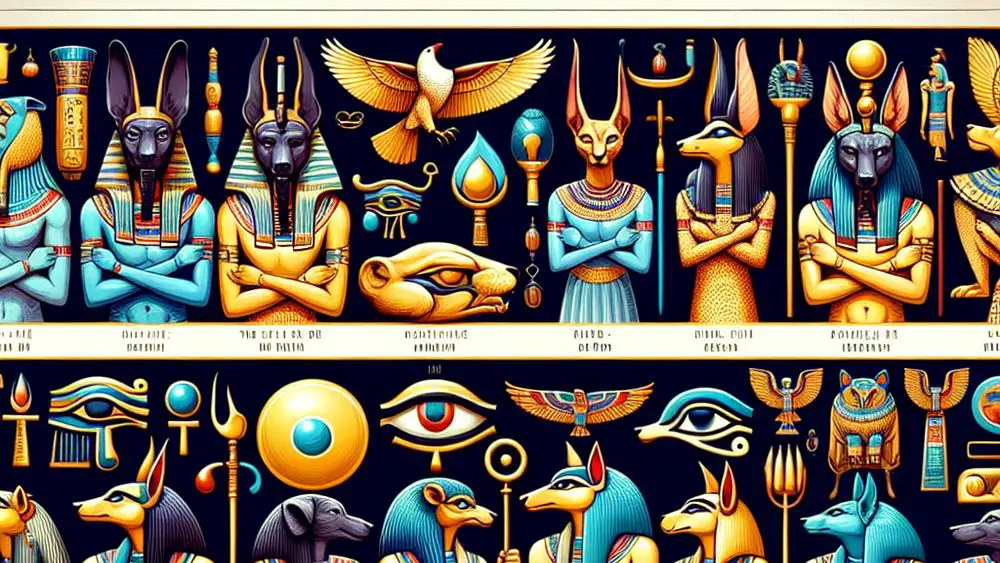
| God | Animal Head | Symbolic Meaning |
|---|---|---|
| Ra | Falcon | Sun, creation, kingship |
| Anubis | Jackal | Afterlife, embalming, protection |
| Thoth | Ibis | Wisdom, writing, knowledge |
| Sobek | Crocodile | Strength, power, fertility of the Nile |
Understanding the symbolic meanings behind the animal-headed Egyptian gods can offer insights into various aspects of life and attributes like wisdom, protection, and power.
The Cultural and Religious Implications of Animal-Headed Gods
The animal-headed deities of Egypt played a central role not just in the pantheon of the gods but in the daily lives of the Egyptian people. These deities were powerful symbols, encapsulating the qualities the Egyptians revered and aspired to embody. Through these gods, Egyptians sought protection, guidance, and understanding of the natural and supernatural worlds that enveloped their existence. The rich tapestry of Egyptian mythology and religion was thus vividly colored by the animal forms these deities took, linking the earth to the sky, the individual to the cosmos, and life to the afterlife in a continuous cycle that still fascinates us to this day.
The Lion Head: Courage, Power, and Protection
The lion, in Ancient Egyptian culture, stood as a symbol of courage, power, and protection. Known for its majestic strength and authoritative presence, the lion represented the fierce protectors of the people and the lands they roamed.
- Sekhmet, a goddess with a lioness’s head, embodied the fierce power and protection aspect, safeguarding the pharaohs and leading them in warfare.
- Lions were also seen as guardians of the afterlife, protecting the dead on their journey.
The lion-headed deities in Egyptian mythology were not merely animals but revered symbols of the qualities they represented. Their form in the pantheon of gods reminds us of the importance of balance, power, and protection in the natural and spiritual world.
The Falcon Head: Sovereignty, Sky, and Vision
The falcon-headed god Horus symbolizes sovereignty, the sky, and spiritual vision in Egyptian mythology. Horus’s eye, known as the eye of Ra, represents the sun and the moon, guarding over the land and its people with vigilance and wisdom.
- Falcons were considered messengers of the sky gods, embodying the bridge between the heavens and the earth.
- As symbols of royalty, falcon-headed gods were depicted on crowns and staffs, signifying their sovereignty over the land of Egypt.
This distinctive animal-headed form serves as a reminder of the god’s connection to the sky, his role as a protector of the pharaohs, and his all-seeing vision that guides and protects the land and its people.
Horus’s symbolism as a falcon-headed god signifies sovereignty, spiritual vision, and protection over the land and its people.
The Ibis Head: Wisdom, Writing, and Knowledge
The ibis-headed Thoth is a deity of wisdom, writing, and knowledge in Egyptian mythology. This god combined the mundane with the divine, offering insights that were essential for understanding both the material and spiritual realm.
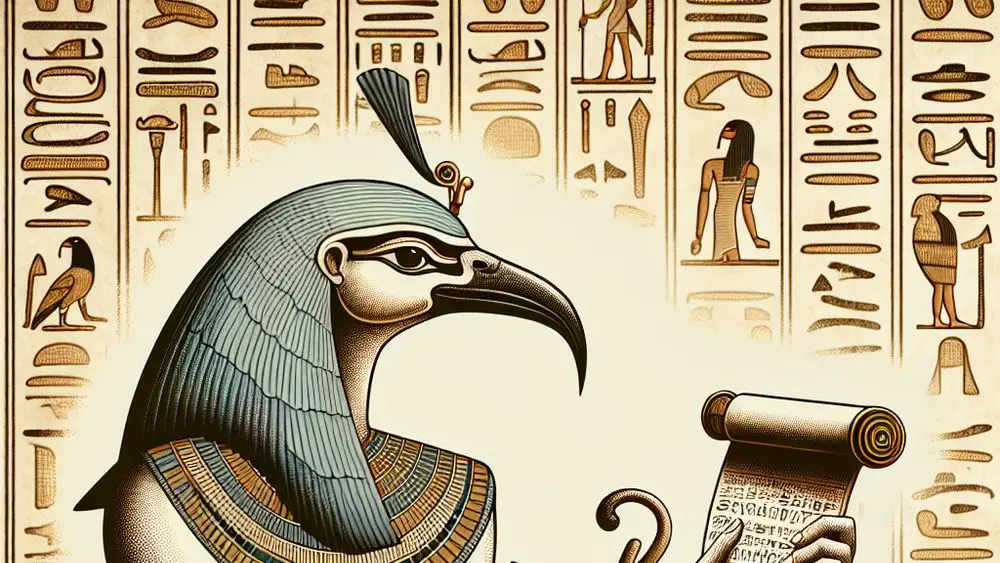
- The ibis, symbolizing Thoth, became associated with the moon, reflecting the balance of light and darkness, and the cyclical nature of life.
- Depictions of Thoth often show him recording the outcome of the weighing of the heart, signifying his role in guiding the dead through the afterlife.
Thoth’s ibis head underscores the importance of knowledge and writing in maintaining order and achieving spiritual enlightenment. It is a testament to the Egyptians’ reverence for wisdom and their belief in the transformative power of words.
The Jackal Head: Afterlife and Embalming
Anubis, with his jackal head, is the god of the afterlife and embalming in Egyptian mythology. The jackal was chosen for Anubis’s representation due to the animal’s strong association with cemeteries and their role as protectors of the dead.
- The jackal’s keen sense for finding and protecting bodies in the desert sands made it an emblem of safeguarding the dead.
- Anubis’s role in mummification and guiding the dead’s spirits asserts the critical importance of death rituals in ensuring a safe passage to the afterlife.
This depiction of Anubis encapsulates the essential Egyptian beliefs surrounding death and the afterlife, marking a sentinel who oversees the transition between the world of the living and the domain of the dead.
Understanding and honoring death rituals is crucial for a safe passage to the afterlife, as symbolized by Anubis in Egyptian mythology.
FAQs
1. Why were animals so revered in Ancient Egyptian culture?
Animals were revered in Ancient Egyptian culture because they were seen as embodiments of gods and spiritual entities. This reverence was rooted in the beliefs that animals possessed qualities essential to the divine, making them integral to religious practices and everyday life.
2. How did the animal heads on gods influence Egyptian society?
The animal heads on gods greatly influenced Egyptian society by embodying the powers and characteristics deemed important for divine intervention. This symbolism guided the Egyptians in their understanding of the divine nature of the world around them, shaping their cultural and religious practices.
3. Can you explain the process of mummification for sacred animals?
The process of mummification for sacred animals involved similar steps to human mummification, including removal of organs, drying out the body, and wrapping it in linen. This process was believed to preserve the animal for the afterlife, reflecting its sacred status in Egyptian mythology.
4. Are there any modern-day practices that stem from the worship of animal-headed gods?
Modern-day practices stemming from the worship of animal-headed gods are mostly seen in symbolic forms, such as the use of animal imagery in art and literature. The enduring legacy of Egyptian deities continues to influence modern spirituality and cultural expressions.
Conclusion
Our journey to uncover the mysteries behind Why Egyptian Gods Have Animal Heads takes us through the winding paths of religious symbolism, cultural practices, and the ancient Egyptians’ deep reverence for the natural world. This exploration not only reveals the rich tapestry of Egyptian mythology but also highlights the universal human quest to find meaning in the world around us.
Reflecting on Why Egyptian Gods Have Animal Heads opens a window to understanding how the ancient Egyptians viewed the cosmos and their place within it. It invites us to continue the exploration, digging deeper into the sands of time to uncover more about our shared human history. Thank you for joining me on this fascinating journey. Let’s keep the spirit of discovery alive. Warm regards, Cedric.

